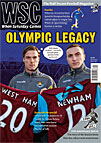 Taylor Parkes despairs at how laddism became the major representation of football fans in the media
Taylor Parkes despairs at how laddism became the major representation of football fans in the media
Through the wonders of modern technology, I’ve been watching 15-year-old episodes of David Baddiel and Frank Skinner’s Fantasy Football League (why I’ve been doing this, when hairshirts are so cheap, is a matter I’ve placed in the hands of my therapist). These days, as you might expect, this once-hip horror looks dreadfully dated and often painfully unfunny, a very obvious ancestor of Lovejoy and Corden’s boorish bollocks.
Yet there’s something surprising here, for those accustomed to what came after: for all its faults, this is a programme for people who like and understand football. The audience chortles knowingly at jokes about 1970s centre-halves; there’s an unstated assumption that the men running the game are preposterous buffoons at best, at worst craven and dangerous. There’s a certain indignation and irreverence floating in all that mid-1990s smugness, all that pernicious laziness.
Which is to say, the show defines its era – peaking around Euro 96, Fantasy Football League now seems a halfway house between the promise of the early 1990s (when, it seemed, a new mood was creeping into football) and the modern media image of fans as matey, muddled, fist-pumping oafs. It’s a long road from the proudly ideological fanzines of 25 years ago to the shattering inanities of Soccer AM and James Corden’s World Cup show. It’s like tracing a line from Karl Marx to Hu Jintao, Perestroika to Putin. Yet the line can be drawn, and following its path through the lad boom of the 1990s highlights certain truths about Britain: how our culture demands that new ideas be stylised and neutralised, and how this fits with that other modern English obsession, making pots of cash.
The “new lad” was the man of the 1990s – unreconstructed but easy-going, a simple bloke with simple concerns. It was a media thing, really; for all its reach it had little to do with genuine “lads”, whose lives remained essentially unchanged by Loaded magazine or the new acceptability of wearing trainers. This was a peculiarly middle-class phenomenon, a slackening of what was expected from well brought-up young men who might once have considered football (or overenthusiastic drinking, or drooling over topless models) a little childish and uncouth. One could argue, charitably, that its first intention was honesty: blokes owning up to their lecherous and slightly pathetic natures, celebrating an eternal, mostly harmless truth.
More than that, though, it was a response to the times, or to a certain reading of the times. For many people in the 1990s – drunk on that “end of history” bunk, the lifting of the nuclear threat and the supposed shutdown of Thatcherism – there wasn’t much wrong with the world any more. All the battles had been won; now we should enjoy the peace, switch off and chill out. It wasn’t sexist to be sexist, because there was no sexism now. Nothing wrong with getting lairy, when you’re not a lairy person. For those sufficiently simple to swallow this reassuring rubbish in a single gulp, liberation meant filling up with beer and cocaine, and behaving like children, revelling in the basic comforts of a liberal modern world.
There was always going to be a crossover between these “new lads” and football – a pillar of blokeishness since records began. That the connections formed should be so solid and lasting culturally is, again, a matter of timing. The image of the football fan and football’s place in popular culture reached its nadir in the 1980s: a game for murderous subhumans, represented on TV by golf sweaters, nostril hairs and cracks about bleedin’ foreigners. As the culture of football supporting changed and ideas born in the fanzine underground filtered through into the mainstream, so there was a shift in how the media chose to handle the game. Now broadcasters took a chance on Danny Baker’s electric brain, James Richardson’s urbane insolence. Around this time, one football publication characterised “new” fans as “pot-smoking, Cameroon-supporting, Pat Nevin-worshipping When Saturday Comes readers” – an odd stereotype for sure, but at least you wouldn’t shudder if you had to sit next to it on the train.
Nothing so awkwardly individual can prosper for long in modern Britain, and even at this point there were worrying signs. One of the earliest attempts to translate “fanzine culture” for teatime telly was Standing Room Only, a BBC programme which ran from 1991, presented by chirpy Simon O’Brien and offering an early chance for Baddiel (with then-partner Rob Newman) to jape about poor gates at Selhurst Park and Saint and Greavsie’s obsequiousness. For all its good intentions the show was unmistakably patronising, with its obsessive good humour and eschewal of difficult ideas, its animated mascot piping: “See you on the terraces!” It provided a warning of how this fresh, less aggressive mode of football support was open to more profitable forms of misinterpretation.
From WSC 290 April 2011